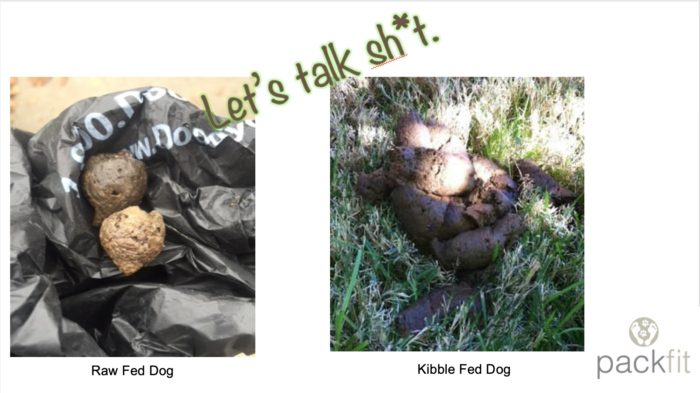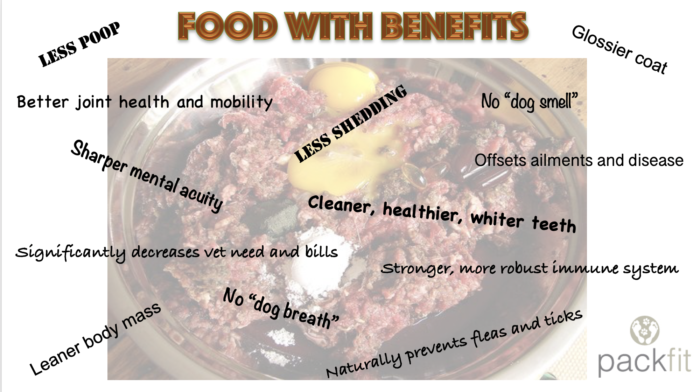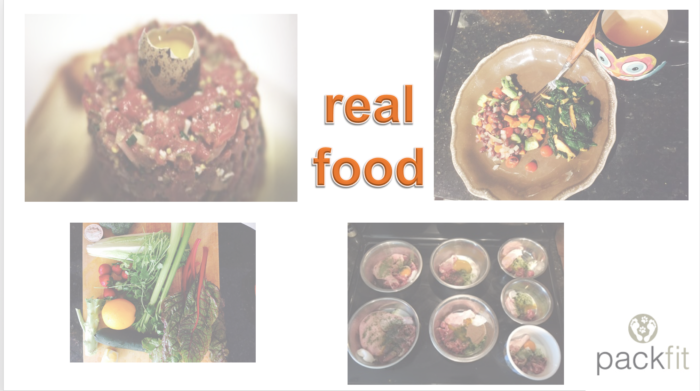The Fundamentals
The fundamentals of nutrition are the same for both dogs and humans. Our choice of consumption is either nourishing or not, supporting health or toxicity, balance or inflammation.
There’s a big difference between feeding and nourishing. Sadly, most of us are merely eating and feeding. Another big difference exists between what is considered real food and food-like product. The latter has become the most accepted and most frequently-served form of dog food.
Physiology Is Information
An animal’s physiology alone already gives us a great deal of information as to what that animal should be taking in for a healthy, smoothly functioning body and a strong, robust immune system. The immune system serves as a key component in natural flea and tick prevention. Eating the kinds of foods our bodies were biologically designed to consume and use provides us with all we need. These nutrients also speak a language our bodies automatically understand and can translate into use and action.
When an animal consumes a diet unnatural to its physiology, this creates malnourishment and inflammation: two of the main culprits underlying the majority of the illnesses and diseases from which we suffering. Examples of unnatural diets include chickens eating a vegetarian or a grain diet instead of consuming a natural diet of bugs, worms, and insects. Another example includes cows eating a vegetarian or grain diet rather than grass. In fact, one out of two dogs receives a cancer diagnosis these days. One out of two! That figure is astronomical and nutrition–or the lack thereof–plays a big part. Things absolutely must change.
Let’s compare the differences between human and canine physiological set up:
Shape of the Teeth
Dogs have mostly pointed teeth, humans have mostly flat, grinder teeth. Now, we do have a few pointed canine teeth, which indicates to me we can take in some meat, but it should not comprise the bulk of our diet. Everything about the human physiology says we’re supposed to be subsisting mainly off of plant matter.
Additionally, the type of meat we typically eat is not at all like the type of meat our ancestors ate. Animals today are typically raised in very inhumane conditions. Crammed in cages with no room to turn their heads, they lay around in their own feces, consume diets totally unnatural to their physiology and breathe and drink polluted air and water.
These animals receive hormones, steroid and antibiotic injections. Cortisol, the stress hormone, constantly courses through their veins. You better believe this kind of meat affects us when we consume it, as it does our dogs. Not only this, but every time we purchase this kind of meat, we’re casting a vote for the practices that got it to us. Dollars are votes in the practice’s favor.
Grinding Motion of Jaws
Dogs have a wide mouth opening in relation to their head size, and very limited movement of their lower jaw. A canine’s jaw cannot move forward and can barely move side to side. When dogs chew, their jaws move in an up-and-down, clamping motion as the tongue pushes the food back.
Humans, on the other hand, are able to move their lower jaw in a more lateral, round motion when chewing. This coincides with most herbivores including cows and deer.
pH Balance & Digestive System
A dog’s digestion only begins once the food hits its stomach. The pH balance in their digestive system is incredibly acidic. This facilitates the appropriate breakdown of protein and kills the bacteria often found in dead flesh.
Human digestion, on the other hand, starts in the mouth. The pH balance in the digestive system is far more alkaline. The problem with humans is we tend to consume more acid-producing foods and beverages, which throws our natural pH out of balance.
Enzymes
Enzymes are responsible for every function and facet of any physical, breathing, living body so obviously they are of importance.
Human digestion begins in the mouth, and starts with the secretion of a carbohydrate-digesting enzyme: salivary amylase. This breaks down cell walls of any consumed carbohydrate, making the nutrition within bioavailable.
Dogs don’t secrete digestive enzymes in their mouths as humans do, which is why they must consume enzyme-rich foods. Food enzymes exist only inraw foods. What does raw mean? Unheated, untainted, unprocessed, and excuse my French but un-effed with. There are two things that diminish a food’s enzyme and nutrient density: death, in other words no longer living and/or separated from its nutrient source, and heat.
In the case of plant foods, as soon as a plant is removed its tree, bush or root system nutrient source, its nutrient value value of enzymes, vitamins, minerals, phytonutrients begins to diminish. When an animal dies, the activity within it dies as well, which is why a “fresh kill” is always better.
As soon as heat is applied to a food, it starts to alter the composition of that food, killing the enzymes, vitamins, minerals and everything that makes that food awesome and whole.
The Importance of Enzymes
I often use a bank account analogy to explain the importance of enzymes. When a body is born, it’s born with a “bank account” of enzymes. When that body takes in enzyme-depleted foods, it dips into its own bank account of enzymes to help digest and process nutrients. If we’re constantly ingesting enzyme-deficient foods and our bodies are having to constantly make “withdrawals” without any “deposits” through enzyme-rich foods, our account eventually goes bust. Hello, malnourishment. What’s up, inflammation? Welcome, disease!
Eating the freshest, raw, enzyme-rich, clean, species-appropriate foods that are close to the source gives the physical body what it needs and helps keep everything in balance and functioning as it should.
Length of Intestinal Tract
The canine intestinal tract is much shorter than ours; it was built to quickly pass flesh.
The human intestinal tract is much, much longer. It ranges from 24 – 28 feet in length and was built to slowly pass plant matter.
Shape of Nails
Canines have sharp, flesh-ripping claws. If we didn’t clip and file them down, they’d be a lot sharper.
Humans, on the other hand, have flattened, more rounded nails.
The type of food we’re eating nowadays is nowhere near the type of food humans and dogs have been eating for thousands of years. It’s wreaking havoc on our bodies, our systems and the planet.
The 411 with Food-Like Product
Neither Kibble, what many refer to as dog food or dry food, nor wet food is real food. Like the bulk of what’s offered and made available to us, they’re both a food-like product. Sadly, like most human, doctors don’t have a strong nutritional background, neither do conventional veterinarians. The bulk of their nutritional education comes from the companies whose food-like products they’re sponsoring and selling for example Hill’s, Science Diet and Royal Canin.
Most of us rely on commercials, advertisements, buzz words. clever packaging and nutritionally-uneducated vets for their nutritional information. We’ve got to get more informed. We’ve got to do our own research. Our dogs, and our dogs’ health, are relying on us.
Food-like products didn’t become mainstream until around the 1950s, when convenience and highly-processed foods started becoming more and more popular. It was all about convenience. This is exactly why we see a direct parallel between both human and companion animal health, with the rise of several illnesses and disease including cancer, diabetes, obesity and arthritis from this time period on.
Dogs consumption of food-like product is analogous to kids living off of cereal every meal, every day for life. High quality or not, it’s still a highly processed, enzyme-deficient food-like product, which also contains a number of additives, preservatives, colors, dyes, and other questionable ingredients that should not enter a living body’s system.
Will a body tolerate it? For a period of time. Should a body live off of and obtain its nourishment from it? Absolutely not. Even if real chicken or salmon are the first ingredients on a label, the product is barely reminiscent of its original state.
Malnourishment & Inflammation
Malnourishment and inflammation are the two primary culprits behind a physical body’s ailments. We’re creating malnourishment from eating what the body is not built to take in, break down, use, and absorb. As a result, we’re creating inflammation as the body’s direct response to it.
What is Biologically Appropriate Nutrition?
We believe in feeding biologically and species-appropriate food, which means we feed according to biology, physiology and the species of animal.
There’s a certain percentage of raw muscle meat (roughly 80%) per raw organ meat (10%, though 5% should come directly from liver) per raw bone (10%) dogs should be taking in. As with people, nutritional needs will vary from individual dog to individual dog.

We always tell clients they have to become a bit of a “poo whisperer.” What a dog eliminates gives us great intel into what they need more or less of. What we’re seeing externally, will give us insight into what’s going on internally.
Feeding real food requires tweaks and adjustments every day, so “reading the poo” helps us to determine what dogs need more of, less of, and what’s just right. If the poo is too light and crumbly, it means the dog is consuming too much bone. Too dark and they’re taking in too much organ meat. The happy little balance is somewhere in between.
Benefits from Feeding Biologically Appropriate

- Cleaner teeth
- Sweeter breath
- Shinier, healthier coat
- Healthier skin
- Less poo. Poop is “waste” because the body is absorbing and utilizing the nutrition the dog is taking in, much less waste is being produced and eliminated.
- No “dog smell”
- Less shedding
- More balanced energy, state of mind, behavior and much more
Of course, this is a much different way of feeding, so we always encourage folks to seek assistance when first starting out. We can provide resources and we also conduct nutritional consultations.
Remember…
Real food nourishes. Food-like products deprive.
Real food heals. Food-like products damage and destroy.
Real food supports. Food-like products erode and compromise.
Real food creates health. Food-like products create illness and disease.
We are what we eat, literally. What is consumed becomes a part of the body that consumed it. It becomes the hair and coat, skin, nails, blood, organs, bones, tissues and absolutely influences thoughts, mood, and behavior. Knowing this, we should be paying closer attention to where we derive our food, how it was raised, what it was injected or sprayed with and whether or not it consumed a biologically appropriate diet. It. All. Matters.
Our dogs’ quality of life and states of health are entirely dependent upon the choices and decisions we make. We’ve got to do better.
Do you have any questions for Kimberly Artley on dogs and behavior? Join the conversation in the comments below!
 Kimberly Artley is the Founder of PACKFIT: Dog Training and Behavior, author of the celebrated book, ‘My Dog, My Buddha.” She has been described as the “Mary Poppins” of dog training. Her experience stems from her game changer dog Lobo. In addition, her background of nutrition, psychology, learning, and human/canine behavior blend seamlessly together. This allows Kimberly to take a comprehensive approach to successfully address a wide variety of canine behavioral challenges.
Kimberly Artley is the Founder of PACKFIT: Dog Training and Behavior, author of the celebrated book, ‘My Dog, My Buddha.” She has been described as the “Mary Poppins” of dog training. Her experience stems from her game changer dog Lobo. In addition, her background of nutrition, psychology, learning, and human/canine behavior blend seamlessly together. This allows Kimberly to take a comprehensive approach to successfully address a wide variety of canine behavioral challenges.


I’ve been feeding raw food since 2007 (Frankenprey method), I would never go back. My 3 Shiba Inu range in age from 11 to nearly 16 and all are in great shape, especially for their age.
Excellent, Lynda~ keep up the great work! x
Both of my dogs are on prescription food from my vet.
America is on a wet diet, The Farmers Dog. I add a little bit of fresh skinless boiled chicken breast or baked sweet potatoes that I boil and bake in advance and freeze in little packets. American loves his food. Warmly, Honey
I read the article but what is the recipe for the food?
Thank you! Pam
Hi, Pam:
Recipes vary, just like we humans eat meals that vary. What’s important is the basic content I shared in the article : muscle meat, organ meat, bone. I’m most happy to conduct a consult with you if you’d like to learn more? Feel free to contact me directly at: kimberly@packfit.net.
What is the recipe for the homemade dog food? Love your column and read them all. Your articles are so positive and have added quality to my life. Thanks!
So wonderful to read, thank you! Recipes will vary, though basic content will remain the same: muscle meat, organ, bone. As mentioned above, I’m most happy to conduct a consult if you’d like to learn more. Feel free to contact me directly at: kimberly@packfit.net. So glad you enjoyed the article!
I am glad you love my column. Thank you!!! I feed America a wet diet, The Farmer’s Dog. America loves the food.Look up the company. I add a little sweet potato or another vegetable at one meal and a little boiled skinless chicken at another meal and sometimes a hard boiled egg. I bake lots of fresh sweet potatoes and make little packets and I freeze them and I do the same with the chicken. Each day I defrost a few little packets. Consult Kim though. I am going to. Warmly, Honey
Very interesting. I will adjust my King Charles dogs’ diet accordingly.
Many Thanks !!!
You are sooooo welcome. My pleasure. Warmly, Honey